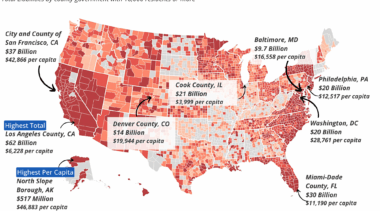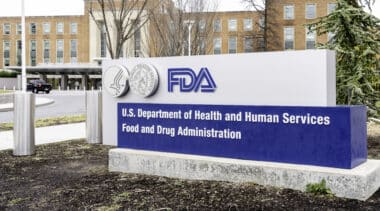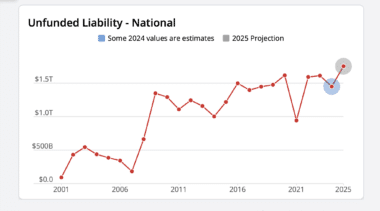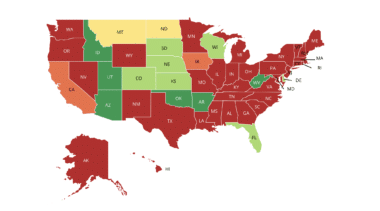-
Proposed Model Policy: “Veterans Mental Health Innovations Act”
This model legislation is intended to authorize state ibogaine research and participation in a larger multistate effort to complete a supervised clinical drug trial.
-
Model legislation would authorize groundbreaking research into ibogaine for mental health
Growing research has demonstrated the promise of ibogaine in treating a wide range of intractable conditions, which could benefit veterans.
-
K-12 Education Spending Spotlight 2025: Annual public school spending nears $1 trillion
Eight states spend more than $25,000 per student: New York, New Jersey, Vermont, Connecticut, Pennsylvania, California, Rhode Island and Hawaii. Public school enrollment fell in 39 states from 2020 to 2023.
-
Report: Cities have $1.4 trillion in debt
San Francisco, Nantucket, New York City, Ocean City, and Miami Beach are the cities with the most per capita debt.
-
Report: County governments have $757 billion in debt
In per capita terms, North Slope Borough, Alaska, ranks first, with its total debt representing $46,883 per county resident.
-
Ibogaine could transform public spending on opioid treatment
Using ibogaine as a treatment for opioid use disorder could be significantly more cost-effective than traditional medication-assisted treatments.
-
FAQ: Timeline for FDA ibogaine approval
It can take between 5 and 12 years to complete a drug trial, but the timeline to drug approval can vary significantly depending on the type of treatment.
-
Ibogaine and veterans’ mental health
Innovative psychedelics therapy offers military veterans struggling with their mental health newfound hope.
-
Ibogaine offers breakthrough treatment for mental health, addiction, and TBIs
Ibogaine, a psychedelic, holds promise as a potential treatment for numerous conditions, ranging from PTSD to multiple sclerosis.
-
Report: State and local pension plans have $1.48 trillion in debt
State pension systems have $1.29 trillion in unfunded liabilities, and local governments have $187 billion.
-
Report ranks every state’s debt, from California’s $497 billion to South Dakota’s $2 billion
Study finds state governments have a total of $2.7 trillion in debt, with 26 states exceeding $20 billion in debt each and 10 states over $70 billion.
-
Report: State and local governments have $6.1 trillion in debt
State and local debt is over $100 billion in 16 states and exceeds $50 billion in 27 states. California’s state and local governments have over $1 trillion in debt.
-
Could clearance rates be key to addressing criminal justice failures?
Clearance rates are the closest metric we have to evaluating how well the criminal justice system does at catching people who commit crimes.
-
Assembly Bill 1383 brings back major pension costs for California
The bill rolls back crucial elements of the landmark PEPRA reform, which would result in billions in extra costs imposed upon California taxpayers.
-
Public schools without boundaries 2025: Ranking every state’s open enrollment laws
Study finds 16 states have statewide cross-district open enrollment and 17 states have statewide within-district open enrollment.
-
Harm reduction: An evidence-based approach to the drug war
Harm reduction includes proven tools like naloxone distribution, syringe service programs, fentanyl test strip access, and supervised consumption sites.
-
Incentivizing US airport privatization
The changes needed to enable US airport P3 leases to compete on a level playing field with airport P3 or privatization activity in Europe, Latin America, and the Asia-Pacific.
-
The Gold Standard In Public Retirement System Design Series
Best practices and recommendations to help states move into a more sustainable public pension model for employees and taxpayers.

















